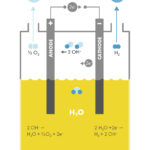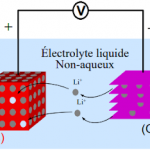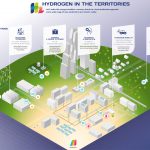The Race For Silicon Anodes
Graphite is the most widely used material for battery anodes. The anode is the positively charged electron collector in a battery. It collects and accelerates the electronics emitted by the battery’s cathode. Graphite gets the anode job because it is has excellent electric conductivity and resists heat and corrosion. Plus it is light weight, soft and malleable.
As satisfied as manufacturers might be with graphite anodes, none would balk at an alternative material that boosts battery performance or reduces cost. Scientists believe battery capacity can be increased as much as ten times by using silicon for anodes. It requires six atoms of carbon to bind one...
Energy Storage as Transmission Explained
by Blackridge Research
The latest trend is that power transmission companies around the world are increasingly looking at energy storage technology to defer or replace transmission system upgrades. How this works is energy storage is placed along a transmission line and operated to inject or absorb power, mimicking transmission line flows. Going with names like “virtual transmission” in Australia and “GridBooster” in Germany, projects totaling over 3 GW of capacity are poised to increase system efficiency and reliability across the world.
Storage as transmission offers an array of benefits over traditional transmission infrastructure. They are faster to deploy, have smaller footprint,...
Nemaska: A Lithium Bargain
Nemaska Lithium (NMKEF: OTC/PK, NMX: TO) is a newcomer to the lithium industry. The company recently came to the market with battery-grade lithium from spodumene rock carved out of its Whabouchi mine in northern Quebec, Canada and converted in a proprietary electrochemical process to battery-grade lithium material at an in-house facility in Shawinigan to the south. The company filled its first orders in Summer 2018.
The company expected to produce over 200,000 metric tons of lithium-bearing spodumene concentrate from its Whabouchi mine with an average 6.25% lithium oxide content. The mine is expected to remain productive for over three decades at that extraction rate. The processing plant in...
Lithium Technology Dominates Large Energy Storage Projects
by Debra Fiakas, CFA
Market share for lithium technology has been extended by another 22 megawatts with the selection of lithium-based batteries by Duke Energy (DUK: NYSE) for three separate of power facilities operated by Duke Energy Florida. Duke did not specify the source of the lithium-based batteries, but the company seems to have an affinity for Tesla’s (TSLA: Nasdaq) battery products. Last year Duke Energy with its partner University of South Florida chose Tesla’s lithium-based batteries for a 100-kilowatt solar project in St. Petersburg, Florida.
Application of lithium-based technology in a relatively small, microgrid application like that in St. Petersburg is no surprise. Lithium-based batteries offer high energy...
Introduction to Electrolyzer Technologies
by Ishaan Goel
Hydrogen has become increasingly prominent as a potential carbon-free fuel, for both automobiles and providing electricity to buildings. It has direct applications in decarbonizing important industries like steel, and can serve as a storage medium for extra renewable energy over seasonal durations too.
Since hydrogen gas does not occur naturally in our atmosphere, its method of production is an essential component of the hydrogen economy. There are several such methods (discussed in detail here), but the one with least emissions involves using renewable power to run electrolyzers - devices that use electricity to convert water into hydrogen and...
EVs, Lithium-ion Batteries and Liars Poker
John Petersen Last week I stumbled across a link that led to a 2010 report from the National Research Council titled "Hidden Costs of Energy, Unpriced Consequences of Energy Production and Use." This free 506-page book takes a life-cycle approach – from fuel extraction to energy production, distribution, and use to disposal of waste products – and attempts to quantify the health, climate and other unpriced damages that arise from the use of various energy sources for electricity, transportation and heat. After studying the NRC's discussion of the unpriced health effects, other nonclimate damages and greenhouse gas...
Metal-Air Battery Stocks
by Debra Fiakas CFA A small Israeli battery developer, Phinergy, is getting attention in the press for a road test of a Citreon C1 car outfitted with Phinergy’s metal-air batteries. Confined mostly to military applications, metal-air batteries have not gained as much attention as lithium-ion applications. Indeed, the Citreon is principally powered by a lithium-ion power package that has been installed in the trunk. Phinergy’s metal-air batteries are to be used as a range extender. Long-use is really the metal-air battery’s main attraction. Like regular batteries Phinergy’s metal-air battery has an anode. It is made from...
Graphite Developers Eye Large Growing Market
The post “Integrated Graphene Producers” featured several graphene producers with novel business models that marry captive graphite sources to the technology and knowhow to produce graphene. These are not the only graphite producers. Although not as elegant as graphene with its svelte single-atom profile, the market for graphite has its appeal as well. Graphite has been a staple in steel industry crucibles, foundry molds and automobile brake linings. These days graphite has moved into another even more important place in cars - lithium ion batteries that make electric vehicles viable as replacements for gas guzzling cars and trucks.
Spherical graphite is especially desirable because the graphite anodes hold...
The Many Shades of Hydrogen
by Ishaan Goel
INTRODUCTION
In 2020, hydrogen shot to the forefront of the renewable energy conversation, with stakeholders making major investments in its growth. The European Union has allocated nearly EUR 400 billion to hydrogen within its Covid-19 recovery package, to ramp up production capacity ~150 times by 2030. Globally, hydrogen production projects under development have nearly tripled (by capacity) with several firms announcing ambitious gigawatt-scaled ventures.
The appeal of hydrogen stems from its excellent capabilities as both an energy carrier and storage medium. Beyond its extensive usage in high-temperature industrial processes and manufacturing, it shows potential in areas that have proven...
A123 Increases IPO Price Range
John Petersen This morning, A123 Systems Inc. (AONE) amended its registration statement to increase the price range for its proposed IPO to $10.00 to $11.50. I take this as an indicator that their IPO road show has been well received and the offering will go to market in a timely manner. While I've avoided commenting on A123's prospectus, business or financing plans, there is one point that deserves some attention. Their prospectus summary says: According to A.T. Kearney, the global lithium-ion battery market for automotive application in HEVs, PHEVs, and EVs is estimated to be $31.9...
Grid-based Energy Storage: Widely Misunderstood Challenges and Opportunities
John Petersen The most widely misunderstood subject in the field of energy storage is the potential for grid-based applications. They fire the imagination because the grid is so pervasive and the need is so great. They also present immense challenges to storage technology developers because the fundamental economic value per unit of grid-based energy storage is very low. While the subject of grid-based storage provides rich fodder for media reports and political posturing, the reality bears little relation to the perception. On March 9th, Lux Research published a sorely needed reality check in a new report titled "Grid...
Electric Vehicles and the Natural Resource Cliff
John Petersen We all love to whine and complain about oil prices because we buy gasoline regularly and that makes the price changes obvious. To solve this overwhelming problem, myopic visionaries with rose colored glasses propose a simple solution – convert personal transportation from vehicles powered by oil to vehicles powered by clean, free and renewable electricity from the wind and sun. Like most fairy tales, it can't happen in real life which means it won't. This is not a technology issue. It's a raw materials issue and electric vehicles cannot solve the problem. In the first...
PEM Electrolyzers – Cracking the Chicken and Egg Problem
by Ishaan Goel
The first article in this series introduced two prominent types of water electrolyzers – alkaline electrolyzers (ALKEs) and polymer electrolyte membrane electrolyzers (PEMEs). Electrolyzers are devices that convert water into hydrogen and oxygen using electricity. They enable energy storage through hydrogen when combined with fuel cells, and can decarbonize hydrogen production for industry if supplied with renewable power. Subsequent articles shall focus on various characteristics of these two electrolyzer variants.
The graph above shows the investment costs ($/kW) of PEMEs and ALKEs as the technology has advanced over time. In other words, they show the initial capital cost...
Should We Worry About Beacon’s Flywheels?
Tom Konrad CFA How material is the failure of one of Beacon Power's (BCON) flywheels on July 27?<a href="http://www.altenergystocks.com/comm/content/beacon-power-corporation/" beacon="" power's="" (bcon) Last week, I published an article Four Clean Energy Value Stocks I'm Buying Now, including Beacon Power as one of the four. My rationale for including Beacon was: Beacon has been operating their first commercial scale 20MW flywheel energy storage plant since early this year without mishap, achieving full capacity in June. They are set to begin construction of their second 20MW plant later this year, 54% of...
Ener1 And Delphi Sign LOI To Form Lithium Battery Joint Venture
ENER1 INC (ENEI) and Delphi Corp. (DPH), today entered into a non-binding letter of intent to create a joint venture to leverage their combined expertise in lithium batteries. Delphi and Ener1 will be negotiating definitive agreements and conducting due diligence in the coming weeks. "The combination of Ener1's vapor deposition process and its nanotechnology for production of high-rate, low-cost lithium batteries with Delphi-developed high energy capacity technology would allow the venture to have a key advantage in penetrating its target lithium battery markets," — Kevin Fitzgerald, Ener1's CEO. ENEI is up over 14% on this news...
McPhy: Growing With Hydrogen
by Debra Fiakas, CFA
Hydrogen system developer McPhy Energy SA (MCPHY: PA) recently reported impressive sales growth in the first half of 2019 - 23% higher than last year. Sales were boosted by delivery of a refueling station in Houdain, France for a bus operation that is 100% powered by hydrogen. New orders for projects in Germany, Bangladesh and Switzerland will keeps the company busy in the month ahead installing additional hydrogen fueling stations and electrolysis equipment for hydrogen production.
Despite the success, McPhy has not achieved profitability. Thus the company remains dependent upon financing to support operations. In 2017, the company secured an equity sales agreement with Kepler...











